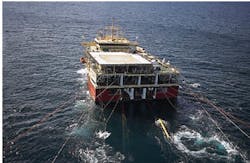PGS plotting multipurpose course for flagship Ramform
Ramform Challenger on a seismic shoot. PGS is now working to realize the potential of the Ramform design in other applications.Conoco's decision to develop the Banff Field using a Ramform production ship represents an important breakthrough for Petroleum Geo-Services (PGS).
"Developing Ramform is our central activity," says John Greenway, vice president for marketing. "In addition to the production ship, we're doing studies on other applications, such as drilling, well intervention, pipe-carrying, and so on." In the case of well intervention the work is sufficiently far advanced to enable the company to bid for North Sea jobs.
The broad stern which gives the Ramform design its characteristic wedge shape makes for a much more stable vessel than the conventional ship shape. For seismic survey purposes, the original use to which PGS has put it, the design enables operations to continue in worse weather conditions than conventional boats can bear. It also permits a large array of streamers - typically 8-12 - to be towed. The net result is faster acquisition of larger quantities of high quality data, equating to a much reduced unit cost.
As a drillship, the company sees the most attractive application as a subsea well intervention vessel. New technology developments related to coiled tubing drilling which are designed into the Ramform intervention vessel concept have a great potential for cost reductions in this type of activity, says Greenway. Moreover, being a relatively small vessel, it does not require a lot of power to keep it on station, he says.
With respect to the FPSO application, Greenway sees the Ramform FPSO carving out a niche position in the small fields market, one which is already in full swing in the UK and looming in Norway. The design offers good weathervaning characteristics, which will contribute to low overall operating costs. Its storage capacity is relatively limited, but storage tankers come relatively cheap, and Greenway does not see this factor as a serious constraint.
The Banff FPSO, which will be leased to Conoco, will have a length of 120 meters and a stern beam of 54 meters, making it somewhat larger than the seismic vessels. Deckload capacity will be 16,000 tons and storage capacity 120,000 bbl, and it will initially be equipped to produce 60,000 b/d. The hull is under construction at the Hyundai yard in South Korea, and the topsides equipment will be fabricated and installed at the Aker McNulty yard in the UK.
An important aspect for Conoco, and for any operator of a complex reservoir such as Banff, is the link which PGS supplies between geophysical description of the reservoir and production, Greenway says. On these kinds of reservoirs, with low nominal rates of recovery, the potential recovery upside through improved reservoir understanding can be very substantial. This creates a win-win situation for operator and contractor, he says.
PGS, which itself was only established five years ago, has the exclusive right to use the Ramform design for some 20 years, although it is committed to building a certain number of vessels along the way. The company came across the revolutionary hull form somewhat fortuitously, when the first such vessel to be built, a surveillance ship for the Norwegian navy, was under construction at the same yard where PGS was having one of its seismic boats rigged. Since then it has left nothing to chance in terms of realising Ramform's commercial potential for the offshore industry.
Last year, its first two Ramform vessels, Ramform Explorer and Ramform Challenger, showed what they were capable of, with a series of record-breaking performances. The Explorer became the first vessel to acquire 1,000 sq km in a month, repeating the feat several times, and the first to tow 10 full-length streamers. The Challenger set a seasonal record for the North Sea summer by acquiring 3,508 sq km.
Two more Ramform seismic vessels - Ramform Valiant and Ramform Viking - are due for delivery in spring 1998. Both are under construction at the Langsten yard in Norway, which built the first two. They are virtually sister-ships to the Challenger, but with a slightly greater operating range of 140 days.
Expansion of the Ramform seismic fleet forms part of PGS's strategy of positioning itself at the high end of the market. As part of the process it sold off its 2D seismic assets last year.
The market has yet to fully assimilate the technological advances of recent times, according to Greenway. "In the last several years, the cycle time for a survey has come down from two years to around nine months, while at the same time the average survey size has increased dramatically," he says. "Customers now expect all this as a matter of course, which creates a big competitive advantage for state-of-the-art vessels," he says. "So we're expecting to see a big shake-out at the lower end of the market."
Copyright 1997 Oil & Gas Journal. All Rights Reserved.
